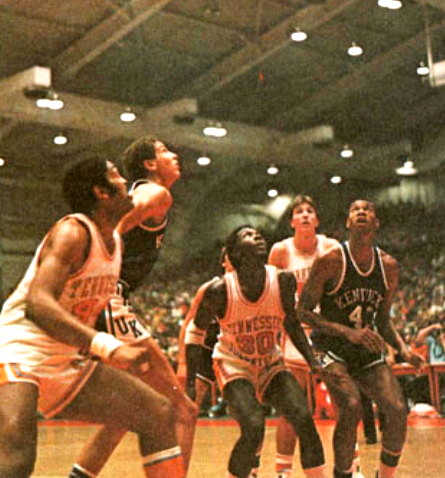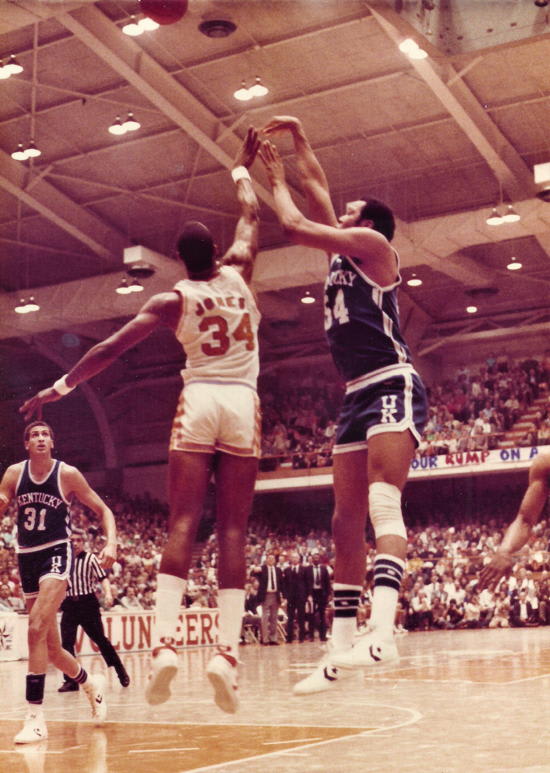
There have been times have been excited about conducting an interview, and then there are really times I have been really EXCITED about conducting an interview.
Chalk this one up to the latter. Oscar Combs is one of the legendary names in Kentucky Wildcat lore. His list of accomplishments are too many to name. Honors such as membership in the Kentucky Sports Hall of Fame, and the Kentucky Journalism Hall of Fame are testimonies to his impact.
He is also the founder and original publisher of Cats' Pause. It is fair to say without his vision I and others like me wouldn't be able to do what we love to do.
He is also a walking library of Kentucky Wildcat athletics history. The Big Blue and Tennessee have met on the hardwood 241 times. He has seen his fair share of those games. HIs vast memory goes back decades and conjures up famous names all the way back to Adolph Rupp and Ray Mears.
Despite all of those games between the two arch-rivals, the Cats and Vols have never met in the NCAA Tournament.........until this Friday night. There is none better to talk to about this border war than Mr. Combs.
It was indeed an honor and a pleasure for him to take us down memory lane.

CI: For a lot of people, myself included, the Kentucky/Tennessee rivalry means a lot. They are border states. People in Kentucky and Tennessee have a lot in common. I think it’s the most underrated basketball rivalry in the country. It’s just a natural rivalry.
Combs: “It certainly is, and Iike you said there is so much that is similar in both states. In the eastern Kentucky mountains and east Tennessee if you didn’t know there was a border between the two you wouldn’t know that. They’ve always been competitors in just about everything sports wise.”
CI: Let’s talk about the history of the rivalry. You told me before we started the interview that there is a common bond between the two that actually kicked off the Kentucky Basketball program into what it would eventually become.
Combs: “There was a guy by the name of John Mauer, and he started out as a college football coach. I don’t know the details of why he went away from football to basketball, but his first head coaching job in basketball was at Kentucky from 1927 to 1930. He did very well, and he asked the administration to give him a raise up to $2,000 a year, not a month, but a year. They declined it, and so he left. He went to Miami of Ohio from there, and that was when they hired Adolph Rupp. After a few years Mauer winds up as the coach at Tennessee, and he actually wins two SEC titles in the early 40’s at Tennessee.”
CI: Kentucky and Tennessee have played over 200 times, and this is the first time they have met in the NCAA Tournament. But only one team could go per league for a long time. Then it was two for awhile. It was tough to get in.
Combs: “Yes it was, and they only got the others in when they started expanding the bracket. At one time you only had 12 teams in teams in the NCAA. It went to 16. Then it went up to 24. When they started having those additional spots was when they started letting the second team get in. The two school that got them to change that was probably the Pac 10, UCLA and Southern Cal. John Wooden was just running everything there. There were a couple of years where Southern Cal only lost two games each year. Both were to UCLA, and they didn’t make the tournament. Certainly they were one of the top four teams in the nation. That brought along more spots in the tournament.
We didn’t even hear about TV big time in the NCAA actually until CBS got involved. When NBC had it in the 60’s, the National Championship was actually played late at midnight. Until the money started rolling in it was just one little thing. Back to the origins of the NCAA Tournament early on the NIT was bigger than the NCAA. The NCAA was three guys in the back room of a bar smoking cigars that would invite teams. There was a lot of plain old favoritism.”
CI: You remember a lot of the big games in the past. Do you think this is the biggest one between Kentucky and Tennessee in history?
Combs: “No, it’s not even close. There were so many regular season games that were bigger than this. It was blood and guts back in the 60’s and 70’s. Everybody will forget this two weeks later. People at Kentucky should not forget that they found themselves in the same exact scenario in 1986. They faced it with two teams, and not one: Alabama and LSU. It’s not totally unheard of, but you go back to the Ernie and Bernie days at Stokely Athletic Center as small as it was. They had a balcony there if you could get down there and hang on pretty good you could probably catch a shot before it got to the goal. I remember a Lexington Herald-Leader photographer who after a big play ran out to shoot a picture. The sheriff there in Knoxville took him and put him in jail.
There was no greater rivalry than the one between Ray Mears and Adolph Rupp the last few years. Rupp didn’t actually coach against Ernie and Bernie. Joe B. Hall did. But it was a fierce rivalry before even that. When Ray Mears came in there he changed the total appearance of Tennessee Basketball. It was nothing until he got there.”

CI: If there is one game you remember between Kentucky and Tennessee which one would it be?
Combs: “Well, there were several. One thing, when Joe B. Hall coached he played Tennessee in Stokely 13 years in a row. He won one game, and that one game was the year they won the (National) title. Probably the game I remember the most was in 1984 when they had the Final Four team. Melvin Turpin went off for 42 points. He was 18 of 22, and they still got beat. That night after that I turned around and said, ‘Joe. B is never going to beat this team in Knoxville.’ There were just so many of them that I don’t know that one actually sticks out. There were so many great ones that they kind of tie themselves together.”
CI: You were talking about 1986. Kentucky beat Alabama and LSU three times apiece that year. They played them back to back in the NCAA Tournament. They were going to have to go a perfect 8-0 against both combined to get to the Final Four.
Combs: “They swept both in the regular season games, and they beat both of them in the tournament. Let me tell you something, all three teams were good that year. By all rights, Kentucky probably shouldn’t have been 4-0 against both of them going into the tournament, but that’s the way it was. When they got down there LSU got a real break, because the NCAA allowed them to host the first two rounds at Baton Rouge. Then they upset Georgia Tech, and got to go to Atlanta.”
CI: You were talking about the Melvin Turpin game. Living in Tennessee I know a few older diehards who actually know the history of the Volunteer Basketball program. Bernard King had a 36-point game against Kentucky that many of them still consider the most memorable performance ever by a Tennessee player.
Combs: “Probably was, and of course on the flip side of that the time that Ernie Grunfield stepped to the free throw line in place of some other player in Lexington.”
CI: How did that go over?
Combs: “It was over before anybody realized what was up. The fans knew what was going on, but apparently the coaches and the referees just blew it.”
CI: You spoke about the animosity between Adolph Rupp and Ray Mears. How was it for Coach Hall and some of the others? Was it as bitter of a rivalry for them?
Combs: “It wasn’t like Rick Pitino and John Calipari. Ray came down there with that New York shine on him. He had the unicycles, and all of that kind of stuff. He liked to be a brash Yankee. Rupp was a good old country boy from the middle of Kansas, and he talked about horses plowing the ground, cattle, and stuff like that. He thought he was the king of basketball, and in some places they consider him that. He didn’t like the way Mears was changing the entire scope of college basketball, and the way it was played and appreciated. What made it even worse was when he lost to him.
I will say this. Ray and I got to be very, very good friends. I guess it was around ’82 or ’83 he sent me a Christmas card every year until the day he died. When I started Cats Pause in ’76 it was probably several months later - my wife did all of the subscriptions and everything. She said, ‘Look here at who we have a subscription from.’ I looked down and it was Ray Mears in Tennessee. He had two subscriptions: one to his office, and one to that facility he checked himself into in Johnson City for a few months. She said, ‘You’ve got another one here too.’ It was a personal check from Ray Mears for a subscription to be sent to his home. So I introduced myself to him, and he said he had seen some copies, and somebody had told him about it (Cats Pause). We got to be really good friends. He would come to Lexington probably about once every three years after he retired until he couldn’t. He was a great guy, and I could see where Rupp would be offended, but that’s just the personality of the two. He got under Rupp’s skin just like Dale Brown got under Joe B.’s skin. It was a great deal similar.”
CI: I remember too how competitive that rivalry was when Bruce Pearl was in Knoxville, and Tubby Smith was in Lexington.
Combs: “That was another thing with Bruce Pearl too. After he got fired he came up to four or five games, and sat on the very front row of Rupp Arena even when Tennessee wasn’t playing. A friend of mine who worked at H.T. Hackney in Knoxville said he (Pearl) was a big fan. I said, ‘Bring him up here for a game.’
Joe B. misunderstood Dale Brown. Dale said, ‘Until I beat Kentucky, I’m nothing in the SEC.’ So it’s the ultimate respect to say I’ve got to beat you, or I’ve not done nothing. Joe didn’t take it that way. To a lesser extent, Adolph was the same way with Ray Mears.’
CI: You’ve seen them all come through. What do you think about Mark Pope, and the program’s future under him?
Combs: “I got to know Mark really, really well when he played here in ’94, ’95, and ’96. I think he is really a great hire for Kentucky. He understands the people here. He understands them even better that I thought he would be able to. He hasn’t been here for pretty much 30 years. But to walk in it’s like somebody gave a crash course. You’ve got 30 days to study this, and when you come back we are going to take a test. I think he’s the right hire. Now, will it work out? I don’t think anybody can say for sure. I have a lot of hope and thoughts that he will. Until you go through the grind you just never know.”